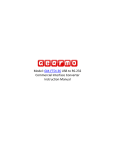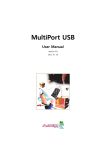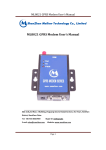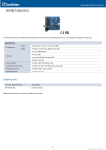Download GM-FTDI-8 User Manual
Transcript
Model: GM-FTDI-8 USB to RS-232 Commercial Interface Converter Instruction Manual Contents 1. Summary 3 2. Functions 3 3. Hardware Installation and Application 3 4. Performance Parameters 3 5. Connector and Signal 4 6. Communication Connection Chart 4 7. USB to RS-232 Communication 5 8. Problems and Troubleshooting 5 Summary With rapid development of computer industry, USB is taking the place of various kinds of traditional low speed peripheral interfaces. However, RS-232 interface designs are still used in many facilities under current industrial environments; therefore, USB to serial converter are used by many users to implement the data transmission from a local host USB port of a computer to RS232 equipment. GM-FTDI-8 is a universal USB to RS-232 interface converter with no external power supply needed. Compatible with USB and RS-232 standards, GM-FTDI-8 is capable of performing the conversion from a single-ended USB signal into UART signal of RS-232. DB9 male connectors are used for connection from RS-232 interface. The unique I/O circuit of the internal zero delay auto transceiver contained in the converter controls the data stream direction automatically. The converter is plug-and-play. All these features ensure a universal application on all the existing communication software and hardware interfaces. The data communication rate can be as high as 300-921.6Kbps by the point-to-point communication by GM-FTDI-8 interface. Power indicator light and data traffic indicator light are also available with the converter for malfunction indication. Conversion from USB to RS-232 is supported. Functions GM-FTDI-8 interface converter supports the following communication mode: 1) Point-to-point communication mode. Hardware Installation and Application Read the user manual carefully before installing the GM-FTDI-8 interface converter. Put the signal cable of the equipment into the USB port.USB and DB9 male connectors (pictured on the left) are adopted for the input/output interface connection for this product. Performance Parameters 1. 2. 3. 4. 5. 6. 7. 8. 9. 10. 11. 12. 13. Standards: Conforming to USB V 1.1, 1.0 and 2.0 and EIA RS-232. USB signals: VCC, DATA+, DATA-, GND, FG RS-232 signals: DCD, RXD, TXD, DTR, GND, DSR, RTS, CTS, RI Working mode: Asynchronous mode, point-to-point mode. Direction control: Adoption of automatic data stream control for automatic recognition and control the data transmission direction. Baud rate: 300-921.6Kbps, automatically detection the transmission rate of the serial interface signal. Transmission distance: 5 meters for RS-232 interface and no more than 5 meters for the USB. Interface protection: surge protection, ±15KV ESD protection. Interface Forms: USB male interface connector and DB9 male connector for RS-232. Transmission media: twisted-pair cable or shielded cable. Dimensions: 200mm Working environment: -40°C to 85°C, relative humidity of 5% to 95% Supports Win98, 2000, 2003, 2008, XP, Vista, 7, 8, CE, Mac, Linux. Connector and Signals 1) DB9 PIN: RS-232 output signals and Pin assignment. DB9 (PIN) 1 2 3 4 5 6 7 8 9 RS-232C Protection Grounding DCD Receive Data SIN (RXD) Sending Data SOUT (TXD) Data Terminal Ready DTR Signal Grounding GND Data Equipment Preparation DSR Request Sending RTS Clear Sending CTS Ring Indication RI 2) USB-A type: USB signal input and pin assignment 1. 2. 3. 4. Communication Connection Chart 1. 2. 3. 4. Standard USB A-type male connector Fine Shell (Black) MCU adopts the product of British FTDI company Standard DB9 male connector VCC DATA-(DM) DATA+(DP) GND USB to RS-232 Communication 1. DCD 2, RXD 3, TXD 4, DTR 5, GND 6, DSR 7, RTS 8, CTS 9, RI RS-232 Device RS-232 Device Problems and Troubleshooting 1. Data Communication Failure a. Check the USB cable connection b. Check the RS-232 interface connection c. Check the power supply (PC or Device) d. Check terminal connection e. Check receive indicator and see if it flashes f. Check send indicator and see if it flashes 2. Data missing or incorrect a. Check to see whether the data rate and format at both ends of the communication equipment are consistent.











